Deformation Behavior and Microstructural Evolution Coordinated Regulation by Compression Deformation for Metastable Ti Alloy
Highlights
- The compression deformation of metastable β-Ti-1023 alloy at low strain rate is more conducive to improving its comprehensive mechanical properties.
- The formation of martensite twins reduces the localization of rapid strain and improves the strength and toughness.
- High strain rate can easily induce α″ martensite to produce preferred orientation in line with special orientation relationships.
- At low strain rate, ductile fracture is dominant, whereas brittleness is dominant at high strain rate.
Abstract
1. Introduction
2. Materials and Methods
3. Results and Discussion
3.1. Analysis of Metastable β Phase Deformation Mechanism
3.2. Effect of Martensite Transformation on Grain Refinement Strengthening
3.3. Influence of Strain Rate on Martensite Orientation
3.4. Relationship Between Dislocation Density and Strain Rate
3.5. Fracture Characteristics
4. Conclusions
- As the increase in strain rate, the double yielding phenomenon caused by martensitic transformation is not obvious, which is due to the stronger tendency of SIMT activation and development under the condition of low strain rate compression deformation. In addition, the compression deformation of metastable β-Ti-1023 alloy at a low strain rate is more conducive to improving its comprehensive mechanical properties.
- During compression deformation, because SIMT is activated at a low strain rate, more β matrix is transformed into α″ martensite and decomposed, resulting in fine grain strengthening. In addition, the proportion of each twin is different in the compression process with different strain rates, which promotes the formation of {130}<30>α″ deformation twins and hinders the formation of {011}α″ combination twins at low strain rates. The formation of martensite twins reduces the localization of rapid strain and improves strength and toughness.
- High strain rate compression deformation is more likely to induce α″ martensite to produce some preferred orientations that comply with SORs, and forms regular changes in α″ martensite orientation. The average values of KAM and GNDs increase significantly with the decrease in strain rate, and the increase in α″ martensite content will produce higher dislocation density due to the continuous activation of SIMT. There is a gradient distribution of dislocation density in all the sizes of α″ martensite, and the grain boundary of α″ martensite can effectively hinder the dislocation movement and produce high strain hardening ability.
- The fracture mode is mainly ductile fracture under low strain rate deformation, and there are a large number of deep and large dimples and a small number of smooth cleavage planes in the fracture surface. Under high strain rate deformation, the brittle fracture characteristics are dominant, the fracture surface is more flatter and close to the plane, the number and size of dimples are significantly reduced, and the area of the smooth cleavage plane is significantly increased.
Author Contributions
Funding
Data Availability Statement
Conflicts of Interest
References
- Hanada, S.; Izumi, O. Correlation of tensile properties, deformation modes, and phase stability in commercial β-phase titanium alloys. Metall. Mater. Trans. A 1987, 18, 265–271. [Google Scholar] [CrossRef]
- Hanada, S.; Izumi, O. Transmission electron microscopic observations of mechanical twinning in metastable beta titanium alloys. Metall. Mater. Trans. A 1986, 17, 1409–1420. [Google Scholar] [CrossRef]
- Chen, C.Y.; Lu, C.X.; Yang, X.J.; Jing, J.R.; Huang, X.; Li, J.S.; Lai, M.J. Remarkable contribution of stress-induced martensitic transformation to strain-hardening behavior in Ti−Mo-based metastable β-titanium alloys. Scr. Mater. 2024, 252, 116254. [Google Scholar] [CrossRef]
- Guan, X.; Liu, D.; Qu, S.; Cao, G.; Wang, H.; Feng, A.; Chen, D. Multiple Deformation Mechanisms in Adiabatic Shear Bands of a Titanium Alloy during High Strain Rate Deformation. Materials 2024, 17, 3645. [Google Scholar] [CrossRef]
- Naseri, R.; Casillas, G.; Mitchell, D.R.G.; Savvakin, D.G.; Ahmed, M.; Furuhara, T.; Pereloma, E.V. Effect of strain on microstructural development during uniaxial compression of metastable beta Ti–10V–2Fe–3Al alloy. Mater. Sci. Eng. A 2021, 804, 140720. [Google Scholar] [CrossRef]
- Ahmed, M.; Wexler, D.; Casillas, G.; Ivasishin, O.M.; Pereloma, E.V. The influence of β phase stability on deformation mode and compressive mechanical properties of Ti–10V–3Fe–3Al alloy. Acta Mater. 2015, 84, 124–135. [Google Scholar] [CrossRef]
- Shang, G.; Gan, X.; Wang, X.; Ge, J.; Li, C.; Zhu, Z.; Zhang, X.; Zhou, K. Effect of Cooling Rate on α Variant Selection and Microstructure Evolution in TB17 Titanium Alloy. Materials 2024, 17, 5010. [Google Scholar] [CrossRef] [PubMed]
- Bertrand, E.; Castany, P.; Yang, Y.; Menou, E.; Gloriant, T. Deformation twinning in the full-α″ martensitic Ti–25Ta–20Nb shape memory alloy. Acta Mater. 2016, 105, 94–103. [Google Scholar] [CrossRef]
- Gao, P.; Fan, J.; Sun, F.; Cheng, J.; Li, L.; Tang, B.; Kou, H.; Li, J. Crystallography and asymmetry of tensile and compressive stress-induced martensitic transformation in metastable β titanium alloy Ti–7Mo–3Nb–3Cr–3Al. J. Alloys Compd. 2019, 809, 151762. [Google Scholar] [CrossRef]
- Chen, N.; Kou, H.; Wu, Z.; Qiang, F.; Wang, C.; Li, J.; Molina-Aldareguia, J.M. Stress-induced α″ martensitic phase transformation and martensitic twinning in a metastable β titanium alloy. J. Alloys Compd. 2021, 859, 157809. [Google Scholar] [CrossRef]
- Ma, X.; Chen, Z.; Xiao, L.; Luo, S.; Lu, W. Stress-induced martensitic transformation in a β-solution treated Ti–10V–2Fe–3Al alloy during compressive deformation. Mater. Sci. Eng. A 2021, 801, 140404. [Google Scholar] [CrossRef]
- Zafari, A.; Xia, K. Stress induced martensitic transformation in metastable β Ti-5Al-5Mo-5V-3Cr alloy: Triggering stress and interaction with deformation bands. Mater. Sci. Eng. A 2018, 724, 75–79. [Google Scholar] [CrossRef]
- Ji, X.; Gutierrez-Urrutia, I.; Emura, S.; Liu, T.; Hara, T.; Min, X.; Ping, D.; Tsuchiya, K. Twinning behavior of orthorhombic-α″ martensite in a Ti-7.5Mo alloy. Sci. Technol. Adv. Mater. 2019, 20, 401–411. [Google Scholar] [CrossRef] [PubMed]
- Lee, H.J.; Kim, J.H.; Park, C.H.; Hong, J.-K.; Yeom, J.-T.; Lee, T.; Lee, S.W. Twinning-induced Plasticity Mechanism of α″-martensitic Titanium Alloy. Acta Mater. 2023, 248, 118763. [Google Scholar] [CrossRef]
- Zhang, X.; Wang, W.; Sun, J.; Gao, Y.; Pennycook, S.J. Enhanced twinning-induced plasticity effect by novel {315}α″/{332}β correlated deformation twins in a Ti-Nb alloy. Int. J. Plast. 2022, 148, 103132. [Google Scholar] [CrossRef]
- Ping, D.; Cui, C.; Yin, F.; Yamabemitarai, Y. TEM investigations on martensite in a Ti–Nb-based shape memory alloy. Scr. Mater. 2006, 54, 1305–1310. [Google Scholar] [CrossRef]
- Zhang, X.; Wang, S.; Wu, J.; Sun, J.; Gao, Y.; He, B.; Pennycook, S.J. ω-Strengthened Ti-23Nb alloy with twinning-induced plasticity developed via reverse martensitic transformation. Acta Mater. 2024, 278, 120234. [Google Scholar] [CrossRef]
- Ma, X.; Li, F.; Cao, J.; Sun, Z.; Wan, Q.; Li, J.; Yuan, Z. Study on the deformation behavior of β phase in Ti–10V–2Fe–3Al alloy by micro-indentation. J. Alloys Compd. 2017, 703, 298–308. [Google Scholar] [CrossRef]
- Bobbili, R.; Madhu, V. Effect of strain rate and stress triaxiality on tensile behavior of Titanium alloy Ti-10-2-3 at elevated temperatures. Mater. Sci. Eng. A 2016, 667, 33–41. [Google Scholar] [CrossRef]
- Niessen, F.; Gazder, A.A.; Mitchell, D.R.G.; Pereloma, E.V. In-situ observation of nucleation, growth and interaction of deformation-induced α″ martensite in metastable Ti–10V–2Fe–3Al. Mater. Sci. Eng. A 2021, 802, 140237. [Google Scholar] [CrossRef]
- Suryawanshi, J.; Singh, G.; Msolli, S.; Jhon, M.H.; Ramamurty, U. Tension-compression asymmetry and shear strength of titanium alloys. Acta Mater. 2021, 221, 117392. [Google Scholar] [CrossRef]
- Ashby, M.F. The deformation of plastically non-homogeneous materials. Philos. Mag. A J. Theor. Exp. Appl. Phys. 2006, 21, 399–424. [Google Scholar] [CrossRef]
- Castany, P.; Yang, Y.; Bertrand, E.; Gloriant, T. Reversion of a Parent {130}⟨310⟩α″ Martensitic Twinning System at the Origin of {332}⟨113⟩β Twins Observed in Metastable β Titanium Alloys. Phys. Rev. Lett. 2016, 117, 245501. [Google Scholar] [CrossRef] [PubMed]
- Salem, A.A.; Kalidindi, S.R.; Doherty, R.D. Strain hardening of titanium: Role of deformation twinning. Acta Mater. 2003, 51, 4225–4237. [Google Scholar] [CrossRef]
- Cai, M.-H.; Lee, C.-Y.; Lee, Y.-K. Effect of grain size on tensile properties of fine-grained metastable β titanium alloys fabricated by stress-induced martensite and its reverse transformations. Scr. Mater. 2012, 66, 606–609. [Google Scholar] [CrossRef]
- Lai, M.J.; Tasan, C.C.; Raabe, D. On the mechanism of {332} twinning in metastable β titanium alloys. Acta Mater. 2016, 111, 173–186. [Google Scholar] [CrossRef]
- Calcagnotto, M.; Ponge, D.; Demir, E.; Raabe, D. Orientation gradients and geometrically necessary dislocations in ultrafine grained dual-phase steels studied by 2D and 3D EBSD. Mater. Sci. Eng. A 2010, 527, 2738–2746. [Google Scholar] [CrossRef]
- Inamura, T.; Kim, J.I.; Kim, H.Y.; Hosoda, H.; Wakashima, K.; Miyazaki, S. Composition dependent crystallography ofα″-martensite in Ti–Nb-based β-titanium alloy. Philos. Mag. 2007, 87, 3325–3350. [Google Scholar] [CrossRef]
- Kundu, A.; Field, D.P. Influence of plastic deformation heterogeneity on development of geometrically necessary dislocation density in dual phase steel. Mater. Sci. Eng. A 2016, 667, 435–443. [Google Scholar] [CrossRef]
- Heima, A.; Shinohara, Y.; Akamine, H.; Nishida, M.; Inamura, T. Peculiar martensitic microstructure and dislocation accumulation behavior in Ti-Ni-Cu shape memory alloys almost satisfying the triplet condition. Acta Mater. 2024, 269, 119823. [Google Scholar] [CrossRef]
- Bantounas, I.; Dye, D.; Lindley, T.C. The role of microtexture on the faceted fracture morphology in Ti–6Al–4V subjected to high-cycle fatigue. Acta Mater. 2010, 58, 3908–3918. [Google Scholar] [CrossRef]
- Wang, X.; Li, F.; Xu, T.; Ma, X.; Hou, B.; Luo, L.; Liu, B. Microstructure and microhardness evolution of Ti-10V-2Fe-3Al alloy under tensile/torsional deformation modes. J. Alloys Compd. 2021, 881, 160484. [Google Scholar] [CrossRef]
- Deng, H.; Liu, J.; Kang, H.; Guo, Y.; Song, L.; Yu, H. Very high cycle fatigue behavior of TC4 titanium alloy: Faceting cracking mechanism and life prediction based on dislocation characterization. Int. J. Fatigue 2025, 190, 108640. [Google Scholar] [CrossRef]

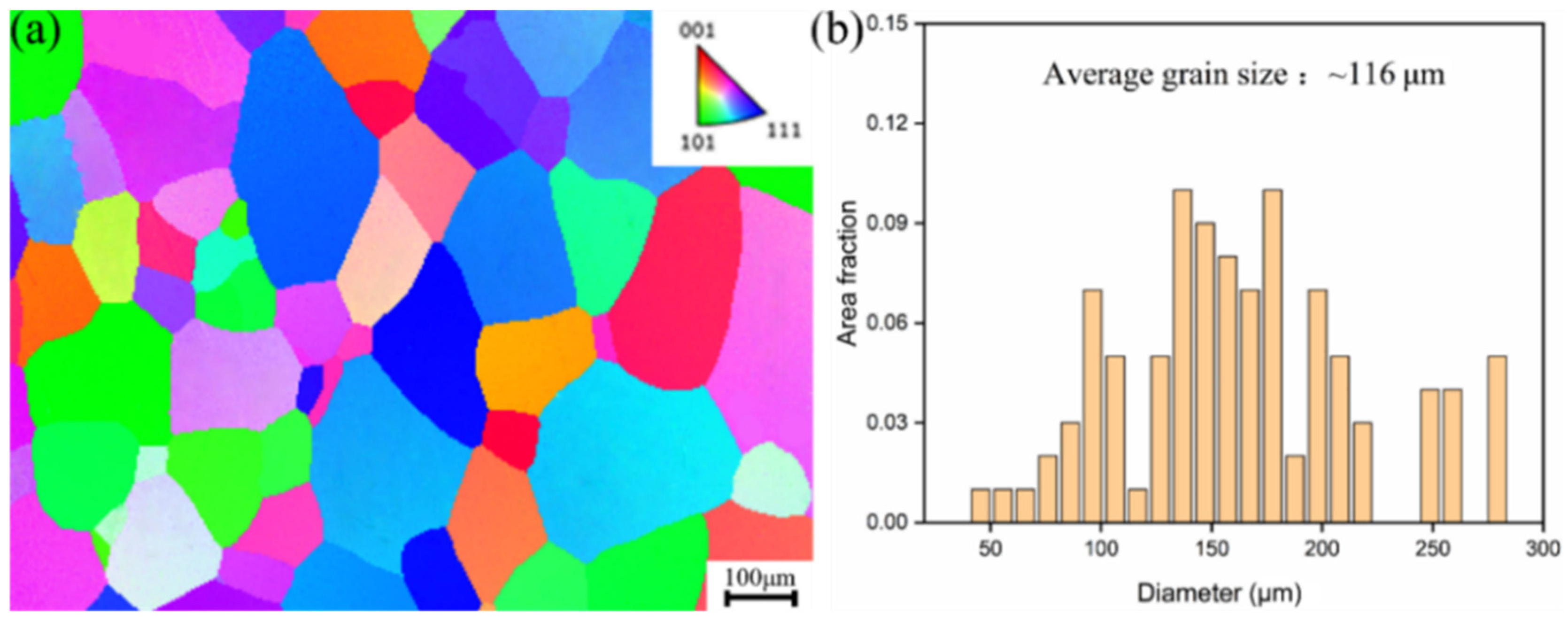

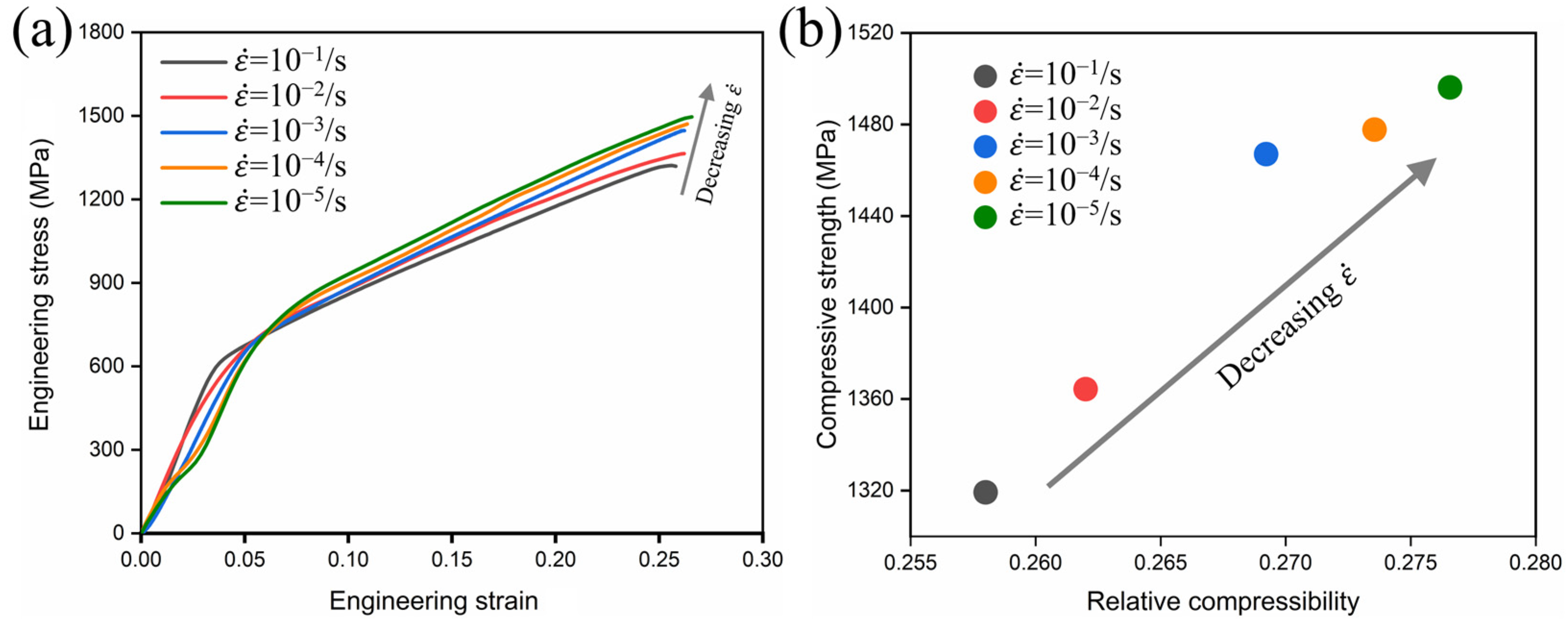






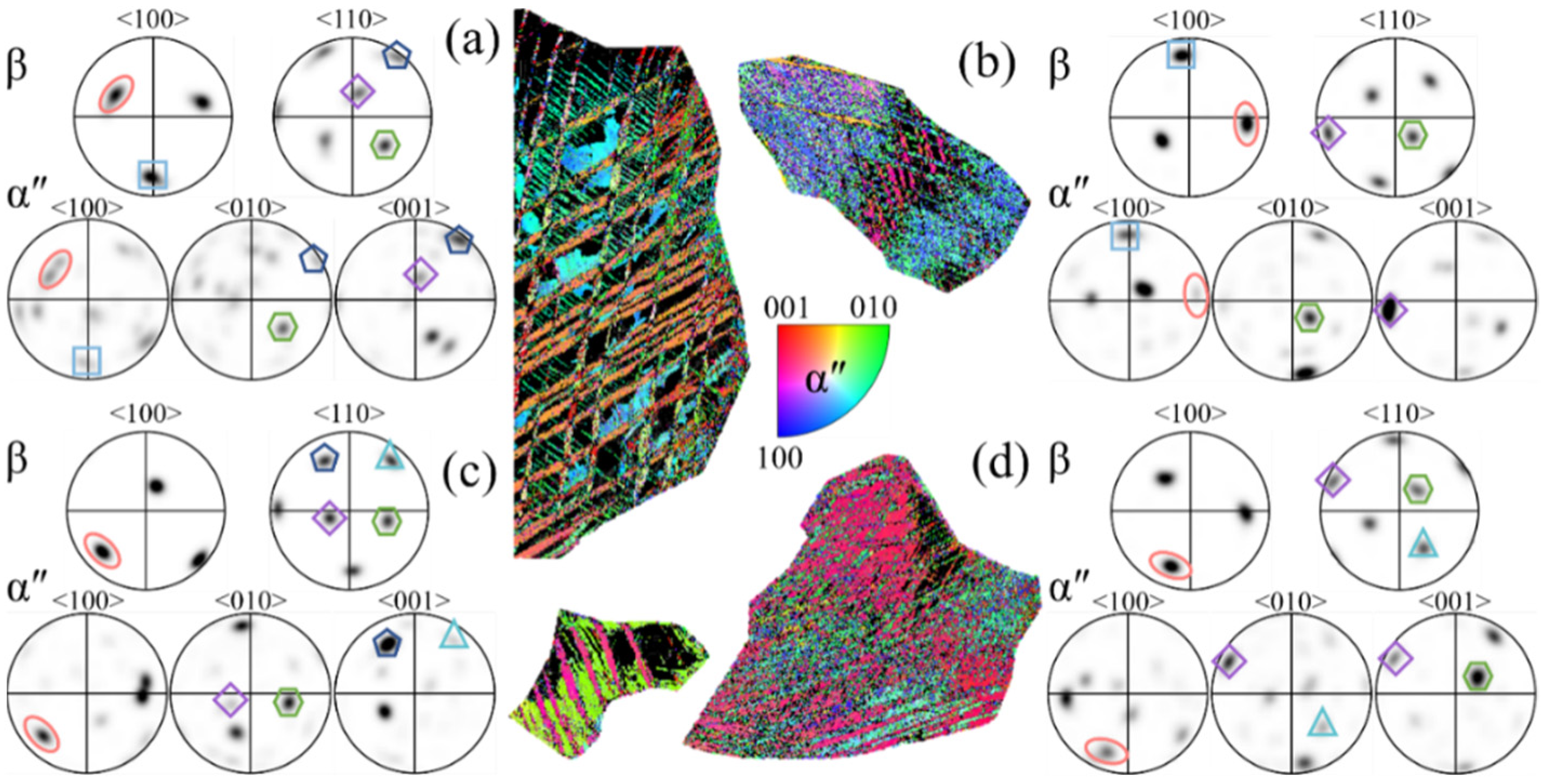
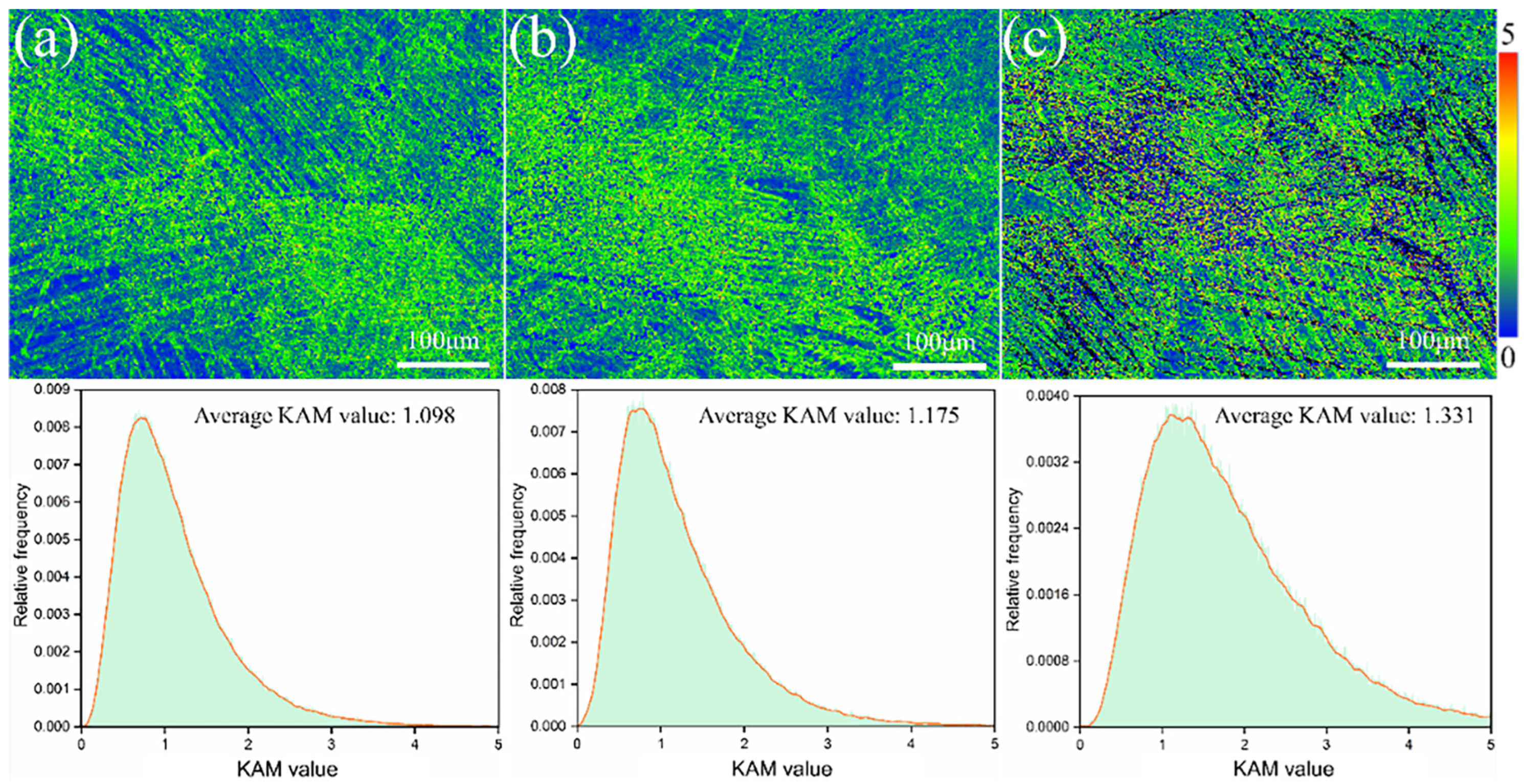
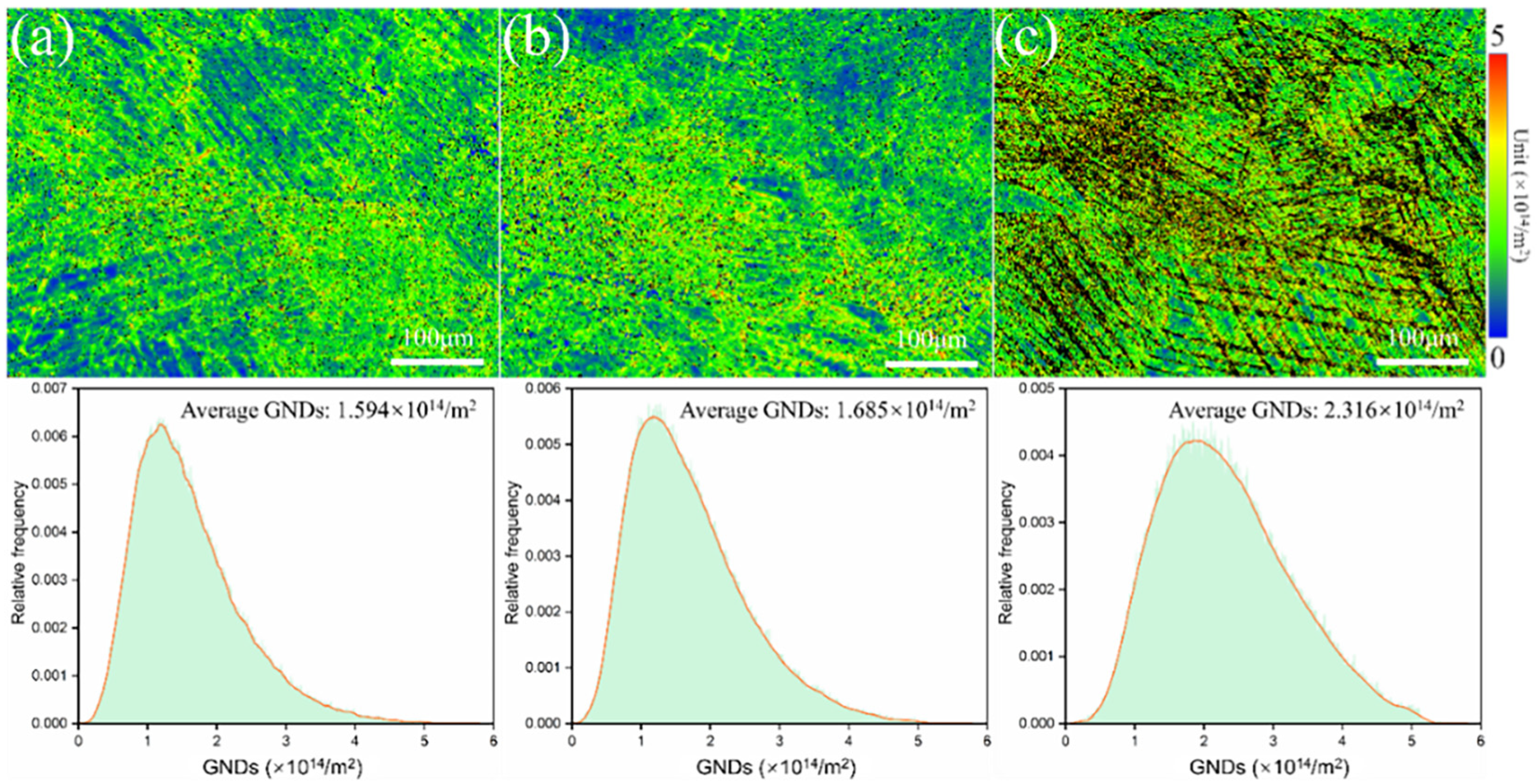
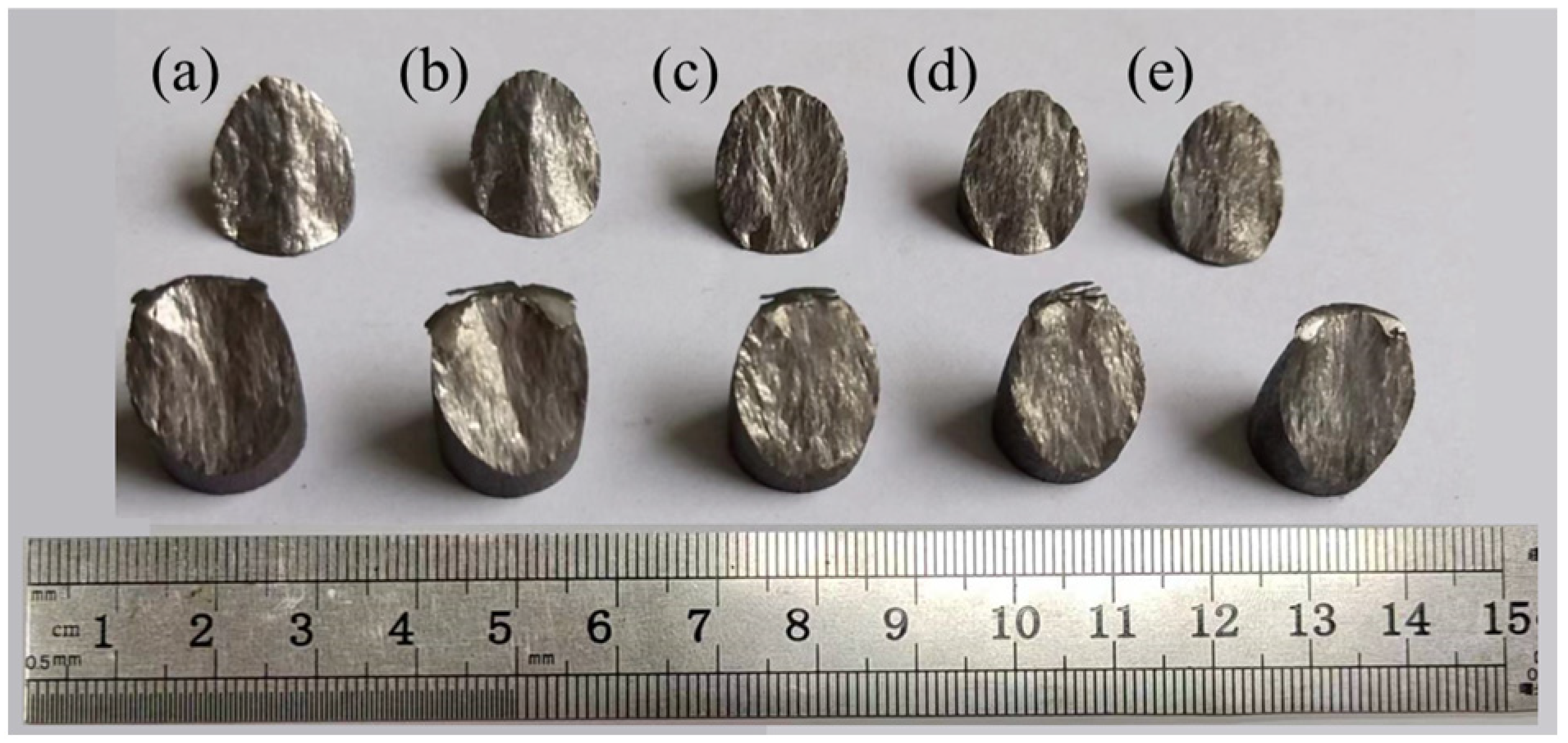
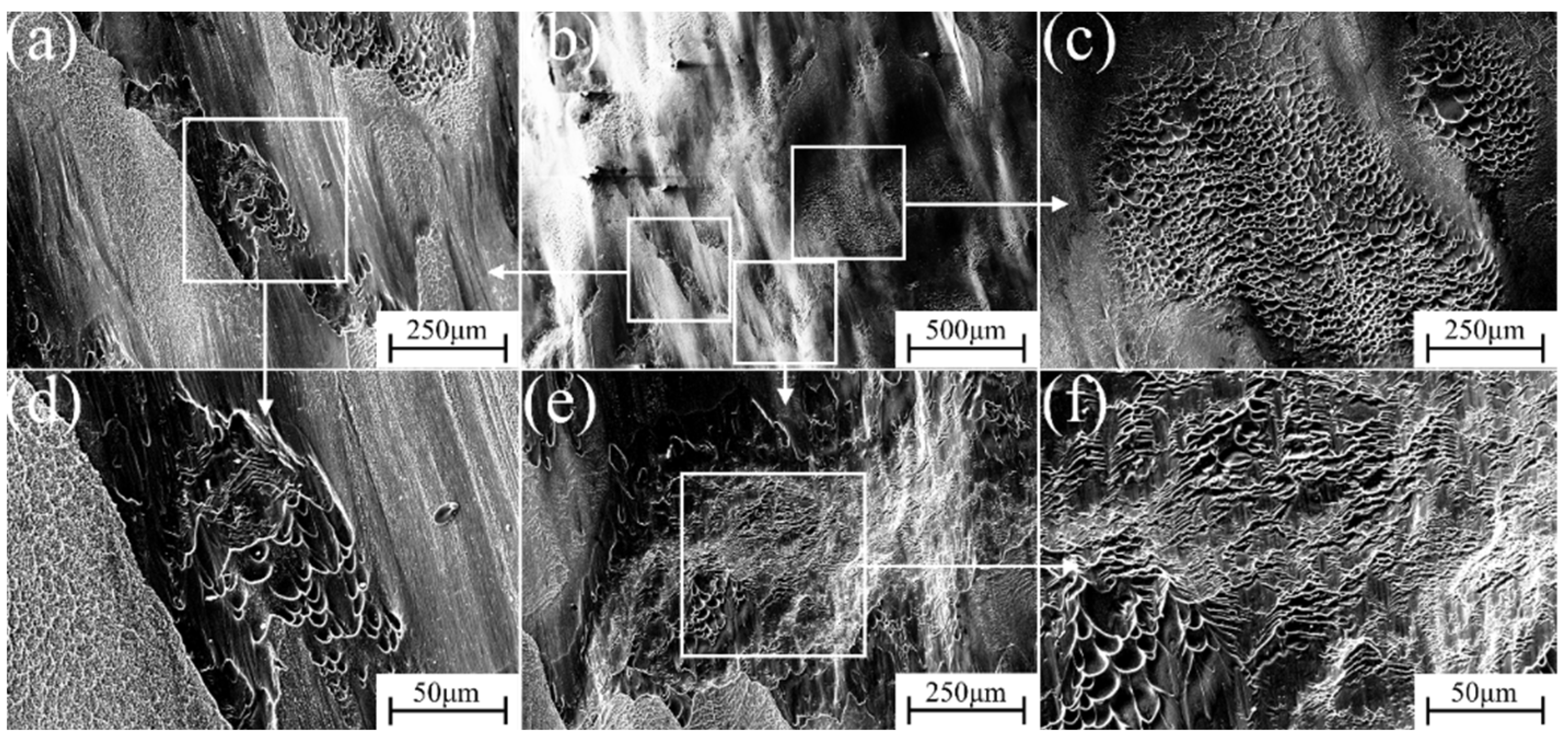




| Element | V | Al | Fe | Si | N | H | O | Ti |
|---|---|---|---|---|---|---|---|---|
| Weights/% | 10.59 | 3.70 | 1.70 | 0.09 | 0.005 | 0.001 | 0.042 | balance |
| Strain Rate (s−1) | = 10−2 | = 10−3 | = 10−5 | |
|---|---|---|---|---|
| Phase composition (%) | β phase | 40.9 | 23.5 | 14.3 |
| α″ phase | 59.1 | 76.5 | 85.7 | |
| Grain boundary composition (%) | LAGBs | 60.7 | 56.6 | 41.6 |
| HAGBs | 39.3 | 43.4 | 58.4 | |
| Proportion (%) | Deformation Rate (s−1) | |||
|---|---|---|---|---|
| Twinning Types | = 10−2 | = 10−3 | = 10−5 | |
| {111}α″ I Type | 0.27 | 0.10 | 0.22 | |
| {211}α″ II Type | 0.70 | 0.88 | 0.44 | |
| {011}α″ Compound | 14.0 | 5.59 | 2.22 | |
| α″ Deformation | 12.4 | 26.5 | 31.6 | |
Disclaimer/Publisher’s Note: The statements, opinions and data contained in all publications are solely those of the individual author(s) and contributor(s) and not of MDPI and/or the editor(s). MDPI and/or the editor(s) disclaim responsibility for any injury to people or property resulting from any ideas, methods, instructions or products referred to in the content. |
© 2024 by the authors. Licensee MDPI, Basel, Switzerland. This article is an open access article distributed under the terms and conditions of the Creative Commons Attribution (CC BY) license (https://creativecommons.org/licenses/by/4.0/).
Share and Cite
Wang, X.; Jia, P.; Wang, T.; Li, F.; Wang, Q. Deformation Behavior and Microstructural Evolution Coordinated Regulation by Compression Deformation for Metastable Ti Alloy. Materials 2024, 17, 6145. https://doi.org/10.3390/ma17246145
Wang X, Jia P, Wang T, Li F, Wang Q. Deformation Behavior and Microstructural Evolution Coordinated Regulation by Compression Deformation for Metastable Ti Alloy. Materials. 2024; 17(24):6145. https://doi.org/10.3390/ma17246145
Chicago/Turabian StyleWang, Xueli, Penglai Jia, Taoqin Wang, Fuguo Li, and Qiang Wang. 2024. "Deformation Behavior and Microstructural Evolution Coordinated Regulation by Compression Deformation for Metastable Ti Alloy" Materials 17, no. 24: 6145. https://doi.org/10.3390/ma17246145
APA StyleWang, X., Jia, P., Wang, T., Li, F., & Wang, Q. (2024). Deformation Behavior and Microstructural Evolution Coordinated Regulation by Compression Deformation for Metastable Ti Alloy. Materials, 17(24), 6145. https://doi.org/10.3390/ma17246145





